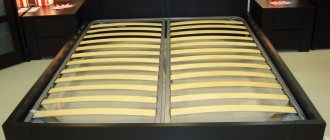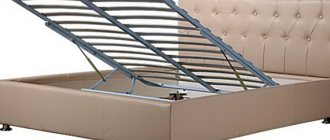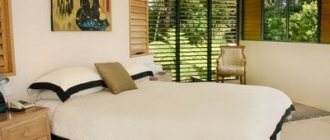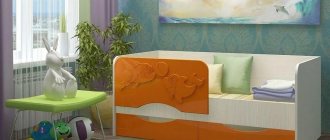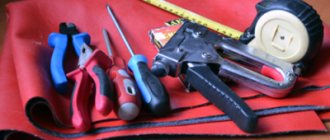77390
Any furniture wears out and becomes unusable. A wooden bed is no exception, even if it is made of high quality materials. After some time, you may notice that the bed is creaking, what should you do in this case to eliminate the unpleasant sound? First you need to establish the cause of the squeak, and only then take action.
Causes of squeaking at the bed
There is a wooden bed in the room and you don’t know what to do. Don’t despair, you don’t need to be a furniture maker to repair it, even any woman who can tell a bolt from a screw can handle it, but if you get confused, it doesn’t matter, the picture will help you. So what to do if it sticks and how to recognize where the sound is coming from.
Creaks in a wooden bed can be in different places; several different approaches will need to be taken to determine it. But let's first look at where creaking can be found:
- Connection of corner parts;
- Where the legs touch the bed frame;
- Wooden slatted base;
- From the contact of the mattress to the frame;
- The spring mattress creaks;
- Feet on uneven floor.
Let's look at how the creaking at the bed occurs. Many people probably know from their school physics curriculum that friction not only causes heat, but also generates sounds. Wooden furniture tends to shrink, thereby creating a gap between the parts that rub against each other, creating this unpleasant squeak. And if the furniture has a long service life, then it seems as if a whole creaky orchestra is playing. Therefore, when examining, you need to listen to each detail separately. The photo shows in red where you need to look for problem areas.
What to do if the frame creaks?
Creaking is typical for a wooden frame, the parts of which dry out over time. And if you do not eliminate the problem from the very beginning of its appearance, then the gaps that form due to dryness will become even larger. Consequently, the creaking will begin to irritate even more and more often.
Therefore, you can simply tighten the fasteners. After tightening, it is recommended to use silicone lubricant. It will reduce friction between parts. If you don’t have any special lubricant at home, a regular paraffin candle will do.
Determining the source of the squeak on the bed
Of course, it will be better to work in pairs, since it will be inconvenient for one person to “wobble” the bed and listen to sounds. To calculate the seats, you need to lie on the bed and turn over, simulating a standard night's rest. At this time, your partner should listen to where the creaking is coming from. It often happens that the source is in the joint of the corner frame or in the places where the legs come into contact with the base of the bed - how to get rid of a squeaking bed.
To fix the squeaking of the bed, we will need open-end or adjustable wrenches if the connection is bolted, or a screwdriver if there is a screw connection. Try to tighten all the connections, but not too much, so as not to crush the wood. If the bed continues to squeak, then you should look for other sources.
It happens that the mattress rubs against the bed - try to level it so that it does not come into contact with the walls of the frame. If the problem is not corrected, you need to move on to an orthopedic foundation. Remove the mattress from the bed to the floor and check it at the same time; sometimes the springs creak.
Lie down on the slatted base and fidget a little; the slats can creak from the pressure on them as your body moves. The bed creaks, what should you do? You can fix the creaking with WD-40. To do this, you need to carefully spray all the connecting places of the bed before tightening the bolts and nuts.
Wear of parts
Often a metal bed creaks as a result of loosening screws and beveled fasteners. This defect can be eliminated by slightly tightening the nuts, but sometimes this is not enough. During long-term use, the bolts and joints may rust. Only special lubrication and treatment will help here.
Sometimes you have to completely replace the bolts or twist the fasteners, but it is better to spend time on such work than to listen to the nasty creaking sounds every time you turn it on its side. More often, this need arises when the fastening is mixed, that is, metal and wood are combined.
The reason for the nasty sound may not be the bed itself, but the mattress, or rather its springs. You won’t be able to fix the problem yourself; you’ll just have to buy a new product. You can determine if a mattress is broken as follows:
- Remove the product from the bed;
- Place it on a flat surface;
- Press down each square of the mattress one by one.
Any man can tighten the nuts and lubricate individual elements of the bed. For such work you do not need special tools or any professional knowledge. If there is a need to replace parts or rearrange them, it is better to contact specialists.
There can be many reasons why a metal bed squeaks. The main thing is to discover the source and cause of their occurrence. Such changes occur not only with metal beds, but also with wooden, combined ones. However, in comparison with these analogues, this material is more durable and does not require special care.
Preparation
If the above methods do not give a positive result, then you will have to move on to more serious work - dismantling the creaking bed. To do this, we may need a tool and auxiliary material to lubricate the rubbing particles:
A set of screwdrivers or wrenches, it depends on the fastener itself;
- Metal corners and screws (wooden reinforcing elements can also be used);
- Paraffin or candle;
- Ski lubricant;
- Graphite grease;
- Litol;
- Laundry soap;
- WD-40;
- Silicone spray;
- Rubber based adhesive.
We prepare all the tools and auxiliary equipment so as not to be distracted in the future.
How to eliminate a musical defect in the lifting mechanism?
If the bed lift mechanism squeaks, you first need to make sure that it is the problem. To do this, you need to raise the sleeping place and swing it up and down and from side to side several times. If there is no creaking, then you need to deal with the bed itself.
If the mechanism creaks, then you need to act like this:
- Check which part is creaking.
- Lubricate the part (for example, WD40 or similar).
Unfortunately, this is almost all that the owner can do on his own. Most gas lift mechanisms cannot be repaired, and it is unlikely that you will be able to tighten the spring yourself. If lubrication does not help, you will have to send the mechanism for repair or replace it with a new one.
Dismantling the bed
To carefully disassemble the bed, you must first understand what fasteners are used on the joints. There are several types of fasteners:
- Bed tie - slats with hooks, in this case you just need to disassemble the bed like a construction set. It is important to remember that they are divided into left and right bars.
- Screw tie – consists of a barrel and a screw. This type of fastening is used for end connections. Unscrews using a hexagon.
- Canonical screed - used to connect chipboards with a thickness of 25 mm, 38 mm. It is unscrewed with a figured screwdriver.
- Euroscrew – this tie belongs to the economy class; a Euroscrew is screwed into a pre-prepared hole. Fastens thanks to a thread in the form of a screw.
- Dowel connection - this type of fastener does not require ties with bolts or screws. Dowels are glued into the drilled holes. After that, glue is applied to the end and the two parts of the chipboard are connected. If such a structure is wobbly, then you can open it with something thin, for example, a flat-head screwdriver. But this must be done evenly so that the gap is the same along the entire length of the sheet.
Disassembly begins with removing the slats and mechanisms (if the bed has a lifting mechanism). Next, the large headboard, which is located at the head of the bed, is unscrewed. After this, you can remove the small one, which is located in the legs.
All fasteners need to be unscrewed and looked at their condition, carefully inspect the threads and holes.
Replace the screw with a bad thread. And broken holes are repaired using glue and a dowel or a wooden chopper (chuck), which you can plan out yourself with a knife. The tree must be hardwood. A dowel soaked in glue is inserted into the broken hole. When the glue dries, the protruding part of the chop needs to be cut off. Then drill a hole in the same place.
How to make a hole - you need to drill a new hole in the center where the screw will go. The diameter of the hole must match the diameter of the screw.
There is an even simpler option; to do this, you just need to wrap electrical tape or tape around the part of the screw where there is no thread. Now you need to try how the screw fits into the hole. If there is no play (does not wobble), then this work is done and the screw will fit like new. Once everything is repaired, you can move on to another task.
Preventive measures
Sometimes it's easier to prevent a squeak than to get rid of it. To avoid squeaking, you should do the following:
- Choose beds from quality materials. It is best to use those made from solid oak or beech - these species resist deformation and do not wear out for a long time.
- Monitor the condition of the fasteners. You should check how tightly the screws and nuts are tightened and whether the screws are seated tightly. If play is detected, tighten it until it stops.
- Check how level the bed is. If the floor is uneven or any of the legs are dangling in the air, you should put a small pad of appropriate thickness.
- To prevent the mattress from creaking, it must be turned over from time to time. In this case, the springs wear out more evenly and do not start squeaking longer.
- If possible, purchase mattresses with independent springs. There is practically nothing to creak in them until fatigue failure of the metal begins - and this takes years.
Treatment of rubbing parts of the bed
When all parts have been removed and inspected, bad screws have been replaced, you can begin processing rubbing parts. To do this, you can take any lubricant and lubricate all the parts with it. This must be done carefully so as not to stain the front part of the furniture. Of course, liquid and thick impregnations will wear off after some time, and the squeak will appear again, but they will still serve for several years.
And if you use silicone compounds, this sound will disappear for a long time. You can use paraffin, all parts are rubbed, after which everything is put back in place.
There is a more reliable processing method, but it is only considered if you do not intend to disassemble the bed in the distant future. To do this, you will need rubber glue, which will create a reliable flexible gasket and at the same time glue all the processed elements together. The operating principle is as follows:
- All disassembled parts and joints of the frame are degreased with an evaporating substance, for example, alcohol.
- When the alcohol dries, you need to apply rubber glue to all prepared parts of the bed.
- The frame is immediately assembled, the legs and all other parts are screwed on.
- It is necessary to allow the structure to dry, after which it can be safely used.
But do not forget that such a variation does not imply a secondary disassembly of the bed. There is another option, gaskets - balsa wood. The cork spacer is cut to size and placed between the boards or parts during assembly. To strengthen the structure, it is recommended to install additional corner fasteners made of metal or wood.
How can I fix it so that there is no sound from the base of the new stock?
Sometimes a furniture manufacturer is slapdash and uses low-quality materials - for example, unseasoned wood. Then, even in the store, the bed may be slightly deformed - not enough to detect it with the naked eye, but already starting to rub against the joints of the base.
You need to do this:
- Determine the source of the squeak.
- Disassemble the bed in the place where the creaking is coming from. If necessary, carry out complete disassembly.
- Thoroughly sand the joints with sandpaper or a sanding attachment on a drill.
- Apply a layer of lubricant. Soap, grease, paraffin, even children's plasticine are suitable. However, over time they wear out and will have to be lubricated again. It is best to apply a layer of silicone grease from the very beginning - one lasts much longer. When working with lubricant, be careful not to get it on the front sides of the bed or in those places where the base comes into contact with the mattress.
Attention
When reassembling, to be sure, you can degrease all joints and apply rubber glue. It will add additional strength to the base and will itself act as a lubricant.

